
The key to succeeding in creating a business is preparation. It can involve a lot of research, which is made easier with a business idea guide or a complete checklist for small business. This article strives to serve as both. For those who are keen on starting their own small business, this may be just what you need.
Evaluate Yourself & Your Target Audience
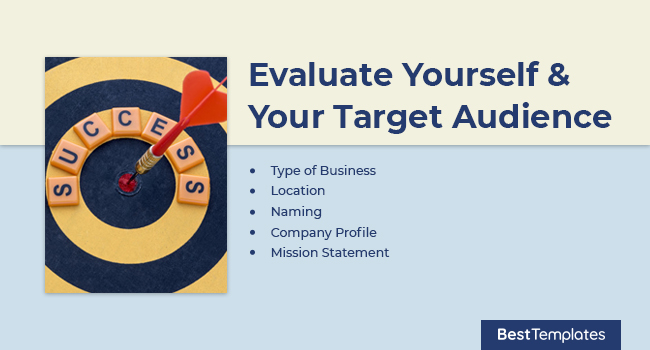
An early consideration to make would be the kind of business you want to establish and what audience you want to attract. Although a bit broad and vague, your choices here will determine every other part of your business. Take the time to solidify your ideas before proceeding any further.
-
Type of Business
Before anything happens, you must first choose what type of business you want to engage in. Your choice may be grounded on something that you are good at; it could revolve around a product or service that you can provide to others. This is your first and most basic choice, which is followed by literally everything else.
-
Location
The success of your venture can depend on where it is situated for a few reasons. One, your target market should be able to find you without trouble. Two, where you are located can impact how your business can be marketed and is perceived externally. Three, depending on whether you choose to rent a space or not, your expenses will be directly impacted. Choose a location wisely with those considerations in mind.
-
Naming
To completely create a brand identity for your business, you need a name. This should be something that’s not too complex. Simplicity is the key to a name that’s easily remembered. It must also be something relevant to your business and far from being obscure.
-
Company Profile
Having a well-written company profile is one way for you to introduce your business not just to customers, but to potential stakeholders as well. This is where your business informs the public regarding its products and services. Map out a strategy and cite the characteristics of your company that you plan to highlight in your profile.
-
Mission Statement
Coming up with a mission statement for your company is a significant part of its development. Through this brief description, you expose to the world just what your company is all about. It can show others what capabilities to expect, what your business makeup is, and how well your customer focus is.
Marketing Analysis

A marketing analysis can be described as your qualitative and quantitative assessment of the market. Through this, you can look into the market’s size, both in terms of value and volume. You can get a closer look at the many customer segments, the buyer patterns, your competitions, and what the economic environment is about concerning regulation and barriers to entry.
-
Demographics & Segmentation
What you have to offer isn’t going to be accepted in the same way by different groups of people. This is the reason why it is important to delve further into demographics and segmentation. Identify which demographics your product or service will appeal to the most. There are multiple ways you can do this; after all, there is segmentation by family, geography, income, gender, and ethnicity. Through this you will get a better idea of what works best on whom.
-
Estimating the Market Value
Defined as the price in which assets are worth in the marketplace, it is necessary to learn how to estimate market value. This is accomplished through multiple ways; stocks and futures are easy enough since their market prices are often made available and tend to be widely disseminated. non-liquid assets, such as real estate, are much harder to estimate. Dependent factors include profitability, broad market environment, and debt load.
-
Target Market
This is defined as the specific consumer group that your company aims at both with its products and services. Since they are the ones most likely to purchase what you are offering, you need to be less vague and general in labelling them. Some do that in hopes of creating a larger market for themselves, only for it to fail compared to more particularly categorized target markets. Go for as much detail as you can instead. Ask questions regarding their gender, age, geographical location, employment, and more.
-
Marketing Needs
To determine marketing needs, you have to place yourself in the shoes of your ideal customer. You can make a list of what they potentially need and go even further through a survey. Even after you have already made a business plan, this is something you may want to do periodically. Few things will stay constant; you need to ensure that what you have to offer continuously pleases your customers and meeting whatever needs they may have.
Competitive Analysis
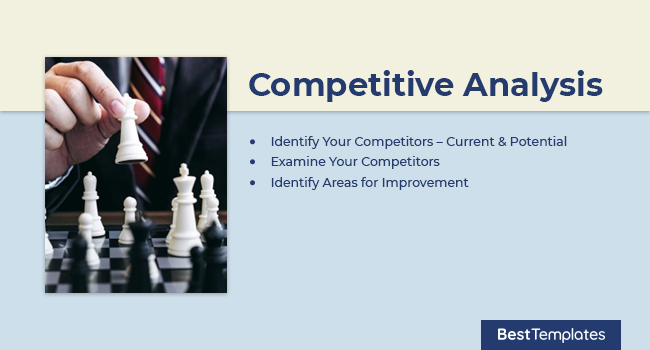
A competitive analysis is crucial to any company’s marketing plan. Through this, you establish how unique your service or product is and which points to play up in particular. Besides that, you also need to evaluate competitors, which is first done by categorizing them according to who directly competes with you and which ones only do so indirectly. Identify said competitors, look into their products or services, and what strategies they have employed in the past and at present.
-
Identify Your Competitors – Current & Potential
Take into account all of your competitors. Not only should you do so directly and indirectly, but who can be referred to as such presently and those who have the potential to be competition. Remember that staying one step ahead means surveying all the players in the game.
-
Examine Your Competitors
Once you have identified your competition, take a closer look at them. Analyze every single aspect of their business; their strengths, weaknesses, what opportunities are available to them, and what poses as threats to their enterprise. By gathering such information, you become better suited to formulating tactics and strategies that can successfully counter them.
-
Identify Areas for Improvement
Now that you know your competitors inside and out, you need to look at yourself and see what you can do to stay ahead of the curve. There’s no doubt that you will have your own weak areas, so concentrate on identifying what those are. From there, do your best to make improvements on said areas.
Marketing Strategies
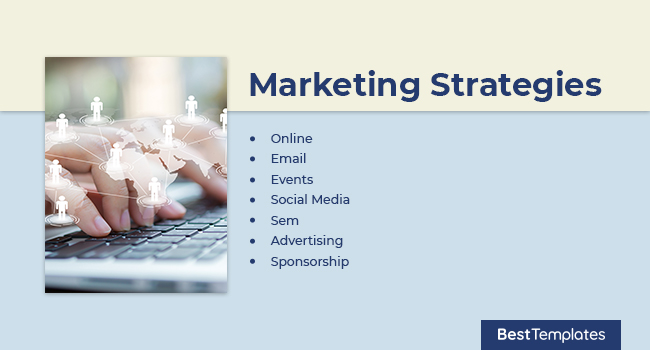
Having decided on a business and with both the market and competitors analyzed, the next step would be to focus on your marketing strategies. In this day and age, there are multiple ways for you to give your business a boost, so it would be smart to take each one into consideration. One may be more effective than another depending on your business’s nature. It is therefore imperative to have a solid grasp of how each strategy works so that you can have a better idea of which path to take.
-
Online
Having an online presence is needed if you want your business to succeed in this modern age. A well-designed and meticulously maintained website is essential because of how versatile it can be as a marketing tool. Your branding would not be as effective without a place where customers can see what the business is all about. Products and services are not just advertised through your site, but they can also be accessed through it. Should your customers need to contact you, a website can be a great place to communicate as well.
-
Email
Email marketing is an effective tool that you can use to directly reach out to both present and potential customers. Considering that there are three times more email accounts than there are Facebook and Twitter accounts put together, this is a smart choice to make. To effectively do this, build up your email list and come up with campaigns that you may want to send. From there, send it out to those in your list and measure the results afterwards.
-
Events
This is a marketing method that deals with creating or designing an event in order to promote your product or service. Highly social and great in terms of generating publicity, the cons here would be the costs of setting up said event and the potential organizational speed bumps along the way.
-
Social Media
The use of social media as part of your marketing strategy would be a smart one, considering how prevalent the platforms are. Facebook, Twitter, and Instagram, among others, can be used to market your products and services in all too convenient ways. Customer interaction is also much easier and the costs of this type of marketing would be kept to a minimum, if you even get to spend anything at all.
-
Sem
Otherwise known as search engine marketing, this is something that involves promoting websites by increasing search engine results visibility. This is accomplished mostly through paid advertising. Another tactic you can incorporate for this would be search engine optimization, which is useful in rewriting website content to get higher rankings in the result pages.
-
Advertising
Also known as traditional advertising, this is where you get billboards, TV, or radio ads for the promotion of your business, products, and services. Less expensive variants may include the use of flyers and coupons. Despite the world becoming more and more technologically advanced, there is still a place for traditional advertising; enough for it to be a viable option for many businesses.
-
Sponsorship
This is among the fastest growing types of marketing in the United States alone. However, it is still in its infancy, specifically concerning the trade show arena. To define sponsorship would be to call it the financial support of a certain activity. It is primarily used to reach your specific business goals. This type of marketing allows you to reach out specifically towards targeted niche markets. It can also serve as a powerful complement to various other marketing programs.
-
Surveys
Surveys can be an important marketing tool because you directly learn more about your customers and potential customers that way. Listening to customers is a great way to build rapport and can help craft a reputation for your business as one with excellent customer service. You may even find that customer feedback can be easily turned into reports or compelling testimonials.
Operations & Management
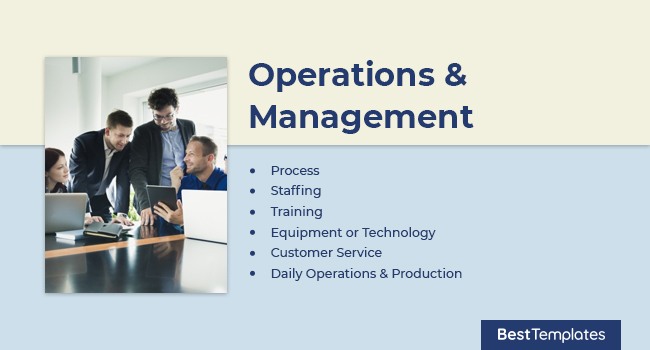
This part involves the administration of your business practices. The concern here is the creation of a high efficiency level within your organization. You need to balance costs with your revenue in order to achieve the highest possible operating profit. In addition to that, there’s also the recruitment of the best people for particular roles and their training. Below are what you can expect to encounter.
-
Process
The process is something that varies between business to business. Your company’s nature and goals will determine what operations and management processes you will engage in on a daily basis. One thing to keep in mind would be to make sure that it is something you can pull off consistently without too much trouble.
-
Staffing
This refers to the process of finding the best suited people for specific roles within the company. The company’s recruitment department is responsible for this, but there are instances where an external organization may perform the screening. Job interviews and the screening of different applicants make up this process.
-
Training
Once an applicant has been hired, training for his or her new role is what follows soon after. This typically takes place over the first few days and is handled by the company’s human resource department. Onboarding and orientation for the new employee may also take place during this time.
-
Equipment or Technology
The acquisition and maintenance of necessary equipment are responsibilities that fall under operations management. It is essential to ensure that the technology being used is up to date and that your equipment is not malfunctioning. Should something go wrong, contingency plans must be enacted to solve the issue as soon as possible.
-
Customer Service
This is defined as the process of making sure your customers attain a decent level of satisfaction for your product or service. Usually, it takes place when a transaction is being done for a customer, like making sales or when returning items for example. It may take shape as an in-person interaction, or perhaps through a phone call, or various other means.
-
Daily Operations & Production
When it comes to operations and production, you need to develop a realistic and attainable structure. Specify the operations management tools that you will be needing, as well as what strategies you plan on employing. Always be on the lookout for updated information that you can use as well. The growth of your business and operations depend on such info.
Financial Plan

Much attention must be paid to the finance part of your business plan. This is the comprehensive evaluation of your business’ financial state. Known variables are used to help predict your cash flows, withdrawal plans, and asset values in the future. In practice, you may work with financial planners in order to craft your financial plans, but there are basic parts of it that you need to get acquainted with first.
-
Sales Forecast
This is a process where your future sales are estimated. When done accurately, your company would be able to create well-informed business decisions. The prediction of performance, both short and long-term, would also be made possible. Forecasts tend to be based on economic trends, previous sales data, and industry-wide comparisons.
-
Expenses
When talking about expenses, you can define this as an economic cost incurred by the business through operations in order to earn revenue. Among the most common business expenses are employee wages, payments owed to suppliers, equipment depreciation, and factory leases. Business can write off their tax-deductible expenses so that their taxable income and tax liability can be lowered.
-
Cash Flow
This is your net amount of cash that is transferred in and out of your business. The assessment of its amounts, uncertainty, and timing is among the most basic of financial reporting objectives. To be able to understand a cash flow statement is critical when assessing your company’s flexibility, liquidity, and general financial performance.
-
Income Projection
This would be where you estimate the financial results of your business in some future period. More often than not, it is presented as an income statement. To be able to create your projected income, you must look into your account revenues, gross profit, costs of the goods sold, and your operating expenses.
-
Assets & Liabilities
If there’s anything to be familiar with, it is the concept of a business’ assets and liabilities. These are the two fundamental elements of what your company’s financial position is. Assets are your resources with economic value. Liabilities are your company’s financial obligations and debts. Due to their opposing nature, you can expect them to go hand in hand at all times.
Mistakes to be Avoided in Business Plans

So now that you’ve taken all those things into consideration, it’s time to take a look at potential mistakes. When writing business plans, there will be a few things that are best left out or done differently. Here are those things. Look over these and ensure that you are not committing them:
-
Don’t Write too Much
Spending too much time writing and planning can lead to the paralysis of your actions. There’s also the fact that you cannot expect to plan for everything, so a margin of error must be included in your plans. If you write too much, there’s a chance you won’t be able to do everything you mean to do anyway, so less is definitely more in these cases.
-
Don’t Confuse Cash with Profits
There are several categories to place your money in. Just because you have some lying around, it doesn’t mean that you can consider these profits, which would be the money gained through your operations. This distinction is a small yet important one.
-
No Focus on Your Competition
Do your best not to make the mistake of underestimating or worse — neglecting — your competitors. Complacency will do more damage to your enterprise than you know. Always account for who the competition is, what they are doing, and what they plan to do.
-
Diluted Priorities
Another thing you need to get a good grip on should be your business priorities. Allowing yourself to get distracted would dilute said priorities and either delay or prevent the achievement of your goals. Write your business plans in such a way that you can prevent this particular mistake.
-
Not Being Consistent
Consistency not only helps you become more effective at organizing your business, but as it translates to the actual operations, it also endears you more to your customer base. Make it a habit as early as the creation of your plans. Inconsistency, on the other hand, can lead to start and stop successes.
-
No Clear Objective
Being vague with what you want is not something that leads to success in business. For each goal, you need to set up specific, measurable, attainable, realistic, and timely objectives. Doing so will exponentially increase the chances of your success.
-
Overestimation of Revenues
This is an easy yet costly mistake to make when coming up with a business plan. Overestimation can lead to the ruin of your future financial plans, strategies, and the mismanagement of your finances over all.
-
Lack of a Viable Opportunity
It would be unwise to focus on something that lacks a viable opportunity to be capitalized on. Be smart about where you spend most of your time and efforts on. Should something fail to yield results, then direct your focus elsewhere.
Plan Templates

Lastly, we are here to discuss the various templates that you can use for your specific needs. There is no one universal way to write your plans, after all. Hopefully through these templates, you would be able to find more specific guides.
-
Sample Business Plan Template

One way to learn would be to sample existing business plans. Through this, you will be able to see how others have outlined their documents, what mistakes they’ve made, and how you can improve upon it. These templates are easy to find and are definitely worth looking into.
-
Business Plan Outline Template

Proper structure is key when organizing your business plan. Acquiring a business plan outline template enables you to create your own plans without having to worry about where to place certain parts and what not.
-
Simple Business Plan Template

As the title of this simple business plan template suggests, this template is far less complex than what you may be used to. You can also expect this template to be much shorter than others. However, it still contains all the necessary information, so there’s nothing lacking at all.
-
Business Development Plan Template

A business development plan template is meant to help you in providing guidance to your company in a variety of ways. This can involve your mission, vision, and your values. This also ensures that the development of your products or services remain consistent, together with your target audience. The specific strategies to employ will also be discussed here.
-
Business Action Plan Template

With the business action plan template, you can expect an outline of your business goals and objectives. For each one, a corresponding tactic or process that is specific and realistic should be outlined as well. Deadlines and results measuring are also involved in this template.
-
Business Plan Template

This is your conventional business plan, with all the necessary structuring and details. If you are having trouble writing one, then this is the most basic and comprehensive template you can acquire.
-
Sample Marketing Business Plan Template

A sample marketing business plan template provides you with actual examples of what to put and what not to put. You can learn first-hand how others have articulated their plans, providing you with the unique opportunity not just to learn but to improve upon original designs.
-
Marketing Plan Template
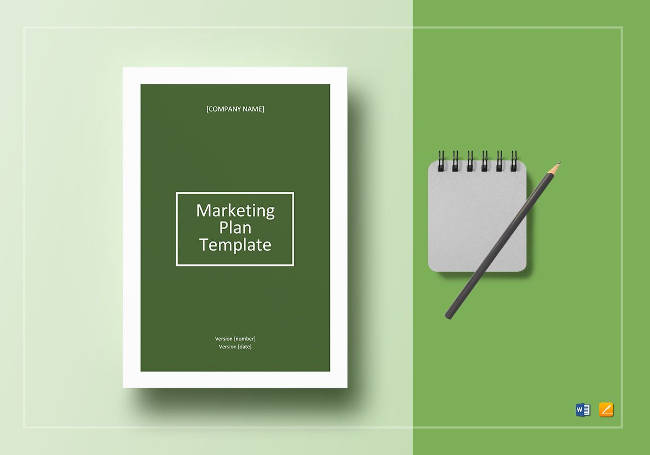
If you’re serious about growing your business, then a marketing plan template is what you need. This should help in identifying your target customers, how to reach them, and how you can retain them once they’ve bought from you repeatedly. More specific details ought to include executive summary, your unique selling proposition, your pricing and positioning strategy, the distribution plan, and promotions.
-
Simple Marketing Plan Template

A simple marketing plan template is, as implied by the name, a much simpler version of the above template. Perhaps it is not as detailed and much more direct to the point. Perfect for those who lack the time or inclination to come up with something long-winded and complex.
-
Sample Sales Plan Template

These samples can help you get some insight regarding sales plans and how you can make one of your own. This is most helpful for those who are new at creating their own plans; taking cues from an existing one might provide useful ideas that might otherwise not be developed.
-
Strategic Sales Plan Template
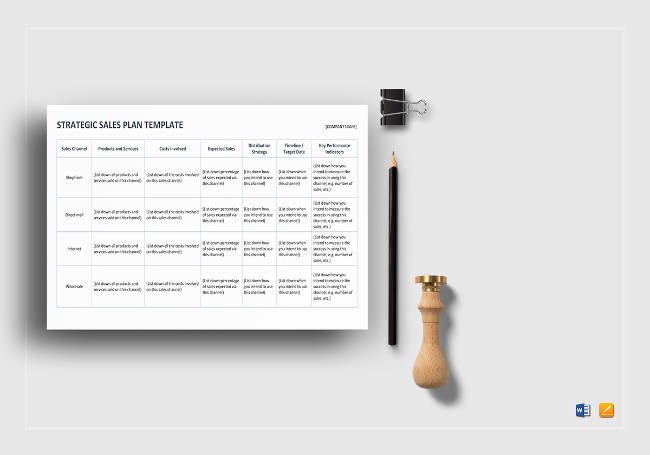
Having a strategic sales plan template can help you streamline your approach to selling into something more efficient and successful. It can include detailed plans that involve your best practices, research information, closing techniques, and even account management policies.
-
Operating Plan Template

This template is used to describe your short-term, day-to-day business strategies. Through this, you may explain how your plans and tactics can be placed into operations. The great benefit of this template is that it can help justify your company’s operating plans.
-
Financial Plan Template

This is the financial plan template you go for if you want to focus solely on the financial aspect of your business. Through this, you can record your revenue, costs, and expenses. You may also better plan out your short and long-term goals in greater detail.
In acquiring a small business or starting one of your own, you need to know how to plan everything out. Hopefully you’ve learned about everything you needed through this guide. Stick to the lessons gained and there’s no reason why you can’t achieve the success you’ve always dreamed of.
